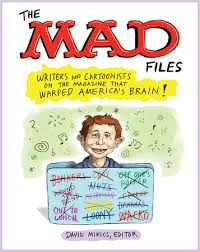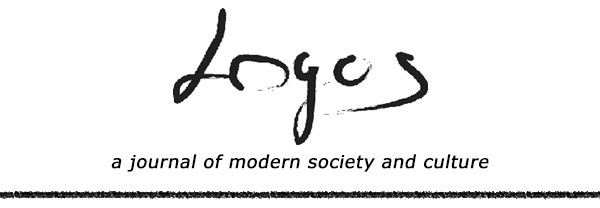David Mikics’ The Mad Files
Long before I ever read the Communist Manifesto, “the Soul of Man Under Socialism,” or A Peoples History of the United States, Mad magazine helped make me a radical. Although Mad had no positive political program to offer, it served as a useful inoculation. Mad encouraged me, as it did for many readers, to see beyond the glittering promises made by advertisers, politicians, and the mass media. Media critic Marshall McLuhan caught the situation well when he wrote in 1964 that “the ten-year-old clutches his or her Mad… in the same way that the Russian beatnik treasures an old Presley tape obtained from a G.I. broadcast.” Mad was a precious symbol of defiance.

I vividly recall the first issue of Mad I ever read. It was the 1999 Mad Star Wars Spectacular, a collection of all their Star Wars material. At that time, Star Wars seemed like the most important thing in my world. It was bigger than Jesus. I didn’t know what to make of the comics in the magazine. Sure, they looked like Star Wars, but it was poking fun at my beloved trilogy! Once I got over the shock, I appreciated the attention and effort went in to parodying the movies I cared so much about. Later on, Mad helped me see the funny side of religion, politics, society, and mass culture; things almost as important as Star Wars.
Mad emerged from the ashes of the 50s anti-comics crusade, and was a cultural phenomenon for decades. Even dedicated Mad skeptic Robert Warshow could write in Commentary that although the publication was “devoted to a wild, undisciplined machine-gun attack on American popular culture” he still “read it with a kind of irritated pleasure.” Nowadays, Mad exists in a diminished form. New material largely stopped in 2019 and it can no longer be found on newsstands.
Last year, the Library of America released The Mad Files: Writers and Cartoonists on the Magazine that Warped America’s Brain! edited by David Mikics. The book collects essays and comics (and one fold-in) by 28 creators detailing the influence the magazine has had “on American life and culture.” The foreign editions of Mad, of which there were many, are left out. A survey of them could and should make a book in itself.
Gary Hendrix and David Hadju both cover the aspect of Mad that enthralled a young me: the film parodies. Hendrix surveys the history of Mad’s cinematic takedowns, beginning with 1954’s “Hah! Noon.” The feature changed alongside the industry. For years Mad spoofed popcorn blockbusters and smaller films, but that changed as studios kept films in theaters for shorter periods of timethe end, Mad was reduced to spoofing films the creators knew would be hits and still in theaters whenever the corresponding issue released. This also explains why parodies of television shows started to displace the ones of films. Hendrix concludes by recounting the amusing tale of an overzealous Lucasfilm lawyer sendingMad a cease-and-desist letter over “The Empire Strikes Out.” Mad’s response was to send a copy of a letter from George Lucas himself expressing how much he enjoyed being spoofed. There were no further problems from Lucasfilm.
Hadju focuses more narrowly on Mad’s musical parodies. The magazine would create lyrics, set to existing songs, and lampoon a film. For example, the climactic battle in Star Wars would be set to “We’re Off to Kill the Bad Guys,” to the tune of “We’re Off to See the Wizard” from the Wizard of Oz. Mad introduced readers to many classic songs via these sendups. I found Darth Vader’s “My Day” well before I ever heard “My Way.”
One of the most prophetic pieces is Geoffrey O’Brien’s 1989 Village Voice piece “Stark Raving Mad.” O’Brien describes how “the age of parody” begun by Mad ended when “potential targets” like Ronald Reagan undermined potential attacks “by deliberately making themselves parodies in advance.” O’Brien was slightly ahead of his time. Although several effective parodies of Reagan spring to mind, most notably Phil Hartman’s on Saturday Night Live, to search for a similarly effective Trump parody is to search in vain.
The New Yorker’s Roz Chast and Art Spiegelman of Maus, contribute short comics on their experiences with Mad. Chast notes with pride her letter to the editor praising their spoof of Love Story as “funnier than the original.” Spiegelman explains that while he “couldn’t learn about America from [his] refugee immigrant parents,” he “learned all about it from Mad.”
Cartoonist and Mad contributor Peter Kuper’s summary of the career of Harvey Kurtzman is longer and more informative. Kuper parodies Kurtzman’s famous war story “Murder on the Imujin” at his opening and closing, a reminder that Kurtzman was equally at home with the dramatic and comedic. Kuper has to cover so much territory in summarizing Kurtzman’s career that his own cartoon Kurtzman attacks him, accusing him of glossing over important milestones. This metafictional touch would be right at home in Mad.
Bonnie Altucher tells the story of Antonio Prohias, Kuper’s predecessor on “Spy vs. Spy.” Prohias fled Castro’s Cuba, and his comic presents a fundamentally Third Camp view of the Cold War. Both sides pull the same tricks and have the same nebulous goal. They are distinguishable only by the colors of their uniforms.
Liel Leibovitz, Mary-Lou Wiseman, Leah Garrett, Daniel Bronstein, and Nathan Abrams all contribute essays on Mad’s Jewishness, paying attention to contrubotors Dave Berg, Al Jaffee, and Will Elder. Berg and Jaffee both contributed to the religious publication The Moshiach Times. Publisher Bill Gaines did not share this devotion. Whenever Berg would greeet him with, “God bless you,” Gaines would respond, “Go to Hell.” Mad’s Jewishness never came across as religious to me. Instead it embodied a certain Yiddishkeit, and its creators embodied historian Isaac Deutscher’s advice to “remain eternal protesters.”
There are three pieces that dampen the overall celebratory mood of the book and keep it from being simply a fond look back at bygone days. The least satisfying contribution comes from underground cartoonist Robert Crumb. It’s not a comic, but a text piece that doesn’t even reach a full page with nothing new to say. It reads like a poor excuse to have another famous name on the list of contributors.
Two others are more substantial critiques of the world of Mad. Cartoonist and critic Sarah Boxer takes the magazine to task for a variety of sins. In her hostile overview, Mad was sexist, unoriginal, and worst of all, unfunny. Even “Superduperman” widely considered one of the best of early Mad, comes in for rough treatment. Boxer complains the social commentary of the story is merely “working women are steel-hearted bitches and the men who work with them do not view them as potential allies or competition but only as a potential piece of ass.” Boxer seems unaware that the comic satirizes the wish fulfillment element of superheroes appealing to men and boys, and the legal battles between DC Comics and Fawcett Comics over similarities between Superman and Captain Marvel. Her argument that Mad was a warren of boys club sexism is also expressed by Rachel Shteir in her survey, “The Women Cartoonists of Mad,” when she makes the unconvincing case that “the #MeToo movement” was “one of the things that pushed Mad into obsolescence.”
Disagreeing with my opening evaluation of Mad’s radicalism, Adam Gopnik’s piece criticizes Mad’s satire as being of a conservative bent. Gopnik writes, “satire was so fertile in the 1950s because satire is…a conservative genre in the first instance.” Gopnik echoes humorist Tim Kreider who writes the magazine’s “ethos was essentially conservative.” If Madwas indeed conservative, a contestable assertion, it was purely by default. Its cynical attitude prevented it from supporting any plan of action or change.
The Mad Files povides an admirable survey of an American humor institution, despite my misgivings with some essayists. Regardless, most show an engagement with Mad and its place in popular culture. The effect is to make one want to seek out reprints in order to spend time with the Usual Gang of Idiots responsible for so much laughter.

